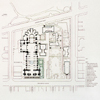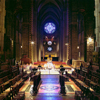| 
THOUSANDS OF TIME CAPSULES still
awaiting recovery, records of their emplacements lost, are
reportedly "out there," lost in the field, but even
more irretrievably lost to memory.
The capsule must be located
in a place that can be reasonably expected to remain in existence
one thousand years from now. In determining this location,
we propose to embed it into a rich tissue of memories made
up of traditions and rites themselves anchored in an architectural
Manhattan landmark morelikely to withstand a thousand years
of tribulations than most others.
One of our goals therefore
has been to embed the capsule within a tradition which, in
spite of radical social and cultural transformations likely
to occur, is unlikely to abandon the present calendar and
the memory of the year 3000. That, of necessity, is a Christian
church whose very temporal life is governed by the present
calendar and traces its origin to the event marking the beginning
of our present time reckoning. We do not mean to favor or
provide "pride of place" to Christianity among the
hundreds of other religions of mankind, many of which also
enjoy rich histories and significant numbers of adherents.
Practical considerations, however, played the major part in
our decision to place our memorial in this location.
History shows that in spite
of wars, pestilences, revolutions and other calamities, European
Gothic cathedrals have stood for more than 800 years with
their stained glass and some of their treasures and bells
still intact. Even some clockworks of the 1300's are still
functioning in Rouen. More ancient monuments - Romanesque
abbeys and churches - have passed the thousand years mark,
and numerous buildings of Roman and Greek origin are still
with us, not to mention the Egyptian Pyramids and pre-Celtic
megaliths. But the surest location, as the Vedas attest, is
still the human mind: the long thread of memory, knowledge
and light that leads on one side to the "blinding point
of rupture of which there is no memory," and on the other,
to the yet unformed, unfathomable and unforeseeable future
of the generations yet to be.
The present calendar on which
we so proudly benchmark days, weeks, months, years, centuries
and millennia is based on an event really meaningful to Christians
only. However, whether the result of manifest destiny or accident
of history, the worldwide Western dominance over commerce
and culture which naturally imposed this calendar on all who
would live in the "modern" world may be but "a
glitch in time." Compared with the much longer and, from
some viewpoints, richer history of China, for instance, who
could guarantee that a thousand years hence, the world may
not be running according to the Chinese or some other calendar,
even a new one based on an event as yet not happened?
Were the geographic locus of
the project to be centered elsewhere than New York City (and,
more widely, the United States and the Western world), the
search for an appropriate location for such a capsule might
well be driven by other considerations, traditions and philosophies.
We propose that the capsule(s)
be located on the grounds of a church and made part of a ritual
- meaningful not only to the religious community within which
it is held, but to the secular community in which that church
resides. |
[click
on images to view larger version]

Location Plan
|
That is why we have chosen
the Cathedral of St. John the Divine. It is in New York City
and it is sacred ground, as the terms of the competition specify.
New York´s Cathedral of St. John the Divine describes
itself as the largest Gothic-style cathedral in the world.
"The Statue of Liberty would fit comfortably under its
central dome. ... Seat of the Bishop of the Episcopal Diocese
of New York and the Diocesan Mother Church," it is chartered
as a "house of worship for all peoples...."
As a cathedral pamphlet puts it,
Conceived as the centerpiece
of an American Acropolis in the lively west side neighborhood
set between Lincoln Center and Harlem, it stands within
a few blocks of such landmarks as Columbia University, Barnard
College, Grant's Tomb and Riverside Church.
The magnificent cathedral
is a monument to the diversity and energy of New York. ...
The Chapel of Tongues represents seven immigrant people
and five centuries of Architecture. ... More than 150 stained
glass windows depict not only religious scenes, but also
a 1925 prototype television. ... The Great Bronze Doors,
cast in the same studio as the Statue of Liberty, are comprised
of sixty panels in bas-relief which depict scenes from the
Old and New Testaments.
The Cathedral Art Treasures,
given by leaders and friends from around the world, include
twin Menorahs (each 12 feet high) donated by Adolph Ochs,
the founder of the New York Times; a pair of ornate cloisonné
vases from Emperor Hirohito of Japan; etc....
The Cathedral of St. John
the Divine, like a medieval cathedral, serves as a center
of inspiration, education and outreach for the whole city
of New York.
St. John the Divine is a living
Cathedral bringing harmony out of the incredible diversity
of New York.
The cathedral itself is an encapsulation
of time: through its architecture, its treasures and its functions,
the church carries forward a tradition more than millenary.
Dedicated to St. John the Divine, author of Revelations,
it hosts in its architecture the rich numerology that the
Apocalypse writer so profusely interspersed in his text.
It is in this tradition that
we want to integrate our proposed time capsule. It is doubly
fitting in the millenarian context of the Revelations.
Such background and qualifications eminently dispose the Cathedral
of St. John the Divine to this project. Preliminary discussions
with the Dean of the Cathedral, the Very Reverend Harry H.
Pritchett, Jr., were extremely encouraging.
|

Nave interior looking West |
